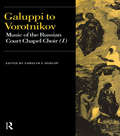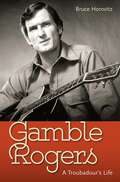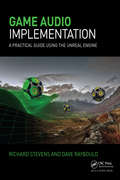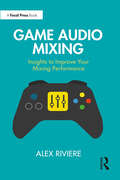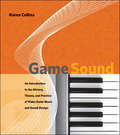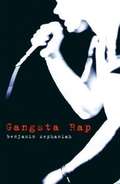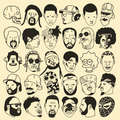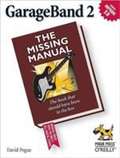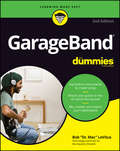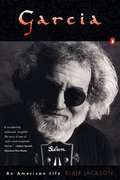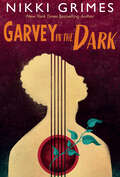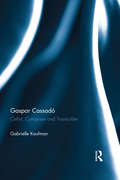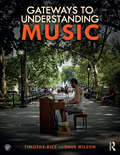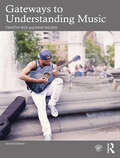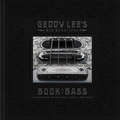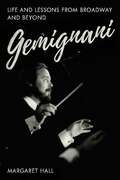- Table View
- List View
Galuppi to Vorotnikov: Music of the Russian Court Chapel Choir I (Music Archive Publications #7)
by Carolyn C. DunlopFirst Published in 2000. Routledge is an imprint of Taylor & Francis, an informa company.
Gamble Rogers: A Troubadour's Life
by Bruce HorovitzFlorida Book Awards, Bronze Medal for Florida Nonfiction Florida Historical Society Charlton Tebeau Award Beloved raconteur, environmentalist, and down-home philosopher, Gamble Rogers (1937–1991) ushered in a renaissance of folk music to a place and time that desperately needed it. In this book, Bruce Horovitz tells the story of how Rogers infused Florida's rapidly commercializing landscape with a refreshing dose of homegrown authenticity and how his distinctive music and personality touched the nation. As a college student, motivated by personal advice from William Faulkner to stay true to himself, Rogers broke away from his family's prestigious architecture business. Rogers was a skilled guitar player and storyteller who soon began performing extensively on the national folk music circuit alongside Pete Seeger, Doc Watson, and Jimmy Buffett. He discovered a special knack for public radio, appearing frequently as a guest commentator on NPR’s All Things Considered. Rogers was known across the country for his intricate fingerpicking guitar style and rapid-fire stage act. Audiences welcomed his humorous homespun tales set in the fictitious Oklawaha County, which was based on places from his own upbringing and populated by a cast of unforgettable characters. His stories evoked rural life in Florida, celebrated the state's natural resources, and called attention to life's many small ironies. As Florida was experiencing colossal growth embodied by the new Kennedy Space Center and Disney World, Rogers's folksy style cheered and reassured listeners in the state who worried that their traditional livelihoods and locales were disappearing. Horovitz shows that even beyond his genius as a performing artist, Rogers was loved for his compassion, integrity, connection with people, and courage. Rogers displayed these widely admired traits for the last time when—on a camping trip to the beach—he tried to save a drowning stranger despite back problems that made it almost impossible for him to swim. This heroic effort led to his untimely death. The life of Gamble Rogers is a window into an important creative subculture that continues to flourish today as contemporary folk artists take on roles similar to the one Rogers established for himself. A modern-day troubadour, Rogers delighted in entertaining audiences with what was familiar and real—by championing the ordinary people of his home community who were closest to his heart.
Game Audio Implementation: A Practical Guide Using the Unreal Engine
by Richard Stevens Dave RaybouldGame Audio Implementation offers a unique practical approach to learning all about game audio. If you've always wanted to hear your sound or music in a real game then this is the book for you. Each chapter is accompanied by its own game level where you can see the techniques and theories in action before working through over 70 exercises to develop your own demo level. Taking you all the way from first principles to complex interactive systems in the industry standard Unreal Engine© you’ll gain the skills to implement your sound and music along with a deep transferable knowledge of the principles you can apply across a range of other game development tools. <P><P> The accompanying website (www.gameaudioimplementation.com) includes: <P><P> <P><P>12 downloadable demonstration games <P><P>A unique exercise level for you to develop for your portfolio <P><P>An up-to-date online bibliography with further reading for each chapter <P><P>A free sound library with hundreds of game SFX
Game Audio Mixing: Insights to Improve Your Mixing Performance
by Alex RiviereGame Audio Mixing offers a holistic view of the mixing process for games, from philosophical and psychological considerations to the artistic considerations and technical processes behind acoustic rendering, interactive mixing, mastering, and much more. This book includes a comprehensive overview of many game audio mixing techniques, processes, and workflows, with advice from audio directors and sound supervisors. Through a series of accessible insights and interviews, the reader is guided through cutting-edge tips and tricks to equip them to improve their own mixing practice. As well as covering how to plan and create a mix that is clear, focused, and highly interactive, this book provides information about typical mixing tools and techniques, such as dealing with bus structure, frequency spectrum, effects, dynamic, volume, 2D and 3D spaces, and automations. Key information about how to deal with a large number of sounds and their prioritization in the mix is also included, from high-level mixing visions to in-depth designs with sound categorizations at the core. Game Audio Mixing is essential reading for all game audio professionals, including those new to the industry, as well as experienced professionals working on AAA and indie titles, in addition to aspiring professionals and hobbyists.
Game Sound: An Introduction to the History, Theory, and Practice of Video Game Music and Sound Design (The\mit Press Ser.)
by Karen CollinsAn examination of the many complex aspects of game audio, from the perspectives of both sound design and music composition.A distinguishing feature of video games is their interactivity, and sound plays an important role in this: a player's actions can trigger dialogue, sound effects, ambient sound, and music. And yet game sound has been neglected in the growing literature on game studies. This book fills that gap, introducing readers to the many complex aspects of game audio, from its development in early games to theoretical discussions of immersion and realism. In Game Sound, Karen Collins draws on a range of sources—including composers, sound designers, voice-over actors and other industry professionals, Internet articles, fan sites, industry conferences, magazines, patent documents, and, of course, the games themselves—to offer a broad overview of the history, theory, and production practice of video game audio. Game Sound has two underlying themes: how and why games are different from or similar to film or other linear audiovisual media; and technology and the constraints it has placed on the production of game audio. Collins focuses first on the historical development of game audio, from penny arcades through the rise of home games and the recent rapid developments in the industry. She then examines the production process for a contemporary game at a large game company, discussing the roles of composers, sound designers, voice talent, and audio programmers; considers the growing presence of licensed intellectual property (particularly popular music and films) in games; and explores the function of audio in games in theoretical terms. Finally, she discusses the difficulties posed by nonlinearity and interactivity for the composer of game music.
Gamelan Girls: Gender, Childhood, and Politics in Balinese Music Ensembles (New Perspectives on Gender in Music)
by Sonja Lynn DowningIn recent years, girls' and mixed-gender ensembles have challenged the tradition of male-dominated gamelan performance. The change heralds a fundamental shift in how Balinese think about gender roles and the gender behavior taught in children's music education. It also makes visible a national reorganization of the arts taking place within debates over issues like women's rights and cultural preservation. Sonja Lynn Downing draws on over a decade of immersive ethnographic work to analyze the ways Balinese musical practices have influenced the processes behind these dramatic changes. As Downing shows, girls and young women assert their agency within the gamelan learning process to challenge entrenched notions of performance and gender. One dramatic result is the creation of new combinations of femininity, musicality, and Balinese identity that resist messages about gendered behavior from the Indonesian nation-state and beyond. Such experimentation expands the accepted gender aesthetics of gamelan performance but also sparks new understanding of the role children can and do play in ongoing debates about identity and power.
Gangsta Rap
by Benjamin ZephaniahSchool, what school? My name is X-Ray-X So be careful how you flex I used to freestyle in me bedroom. But me daddy got me vex. The teacher kicked me out of the classroom. Now I'm rapping in The Rex. Ray has trouble at home and trouble at school. It's the last straw for everyone when Ray and his friends Prem and Tyrone are permanently suspended. But they know what they want, more than most, perhaps. Their headmaster decides to give them a second chance, a chance to live their dream of forming a rap group. Through a specialized social program, the boys are taught the business of the music industry, what it takes to record an album, and how to lay down a track. Within weeks they have become the Positive Negatives, and within a few months they have signed a record deal and are on their way to the top. But their dream soon becomes a nightmare as violence escalates around them. Suddenly, not only their careers but their very lives are at stake. The Positive Negatives are determined to prove that you don't need to be a gangster to be a great rapper.
Gangster Doodles
by Marlon SassyA collectible, four-color illustrated A–Z treasury of gangster rappers, the hip-hop high-life, and notorious pop culture history, told through a series of graphic doodles on 3” x 3” sticky notes.Four years ago, a Post-it® note changed Marlon Sassy’s life. Using office supplies “borrowed” from his admin job, Sassy began creating colorful sketches of rappers in highlighter, Sharpie, and pen. He made his debut posting his rendition of Snoop on Tumblr under the pseudonym “Gangster Doodles.” Next was Bart Simpson and Biggie, then Yams and Yeezy. Soon, he had amassed a cult following of fans who clamored for his next artistic interpretation.Gangster Doodles brings together more than 400 of his most popular illustrations with thirty never-before-seen pieces. An impressive and comprehensive A–Z compendium, it features everyone from Black Jesus to Beyoncé, Kendrick Lamar to LeBron James, Jean-Michel Basquiat to Young Thug, and Kermit the Frog to Action Bronson. This is the ultimate gift for rap fanatics and pop culture addicts alike.
GarageBand 2: The Missing Manual
by David PogueWhether you're a professional musician or a mere novice, Apple's GarageBand software has everything you need to produce commercial-quality recordings entirely on your own. Just imagine how many thousands of singers and instrumentalists remain undiscovered because they lack the capability to produce viable demos. Well, no more. Now there's no need to assemble a backup band or book time at a professional studio--GarageBand has it covered. And GarageBand 2: The Missing Manual gives you the know-how you need to make it all happen. It's an authoritative, witty guide to constructing digital recordings with GarageBand. Written by the master of the Missing Manual series, and a musician himself, David Pogue, this top-selling book shows you how to maximize the program's entire set of tools. Pre-recorded loops, sampled sounds, live recordings--they're all explained in easy-to-understand language. It also shows you how to apply professional-sounding effects like reverb or chorusing, and then export the finished product to iTunes, where you can download your work to an iPod, export it as an MP3, or burn it onto CDs. Now revised to reflect GarageBand's latest features, this book's second edition also addresses how to: use GarageBand's eight-track capabilities display music notation in real time enhance timing and pitch for better quality recordings change the tempo and key of recorded instruments tune guitars with GarageBand before recording So if you're chasing a dream or just having fun, GarageBand 2: The Missing Manual is the only resource you need to make the finest musical recordings possible.
GarageBand 2: The Missing Manual
by David PogueWhether you're a professional musician or a mere novice, Apple's GarageBand software has everything you need to produce commercial-quality recordings entirely on your own. Just imagine how many thousands of singers and instrumentalists remain undiscovered because they lack the capability to produce viable demos. Well, no more. Now there's no need to assemble a backup band or book time at a professional studio--GarageBand has it covered. And GarageBand 2: The Missing Manual gives you the know-how you need to make it all happen. It's an authoritative, witty guide to constructing digital recordings with GarageBand. Written by the master of the Missing Manual series, and a musician himself, David Pogue, this top-selling book shows you how to maximize the program's entire set of tools. Pre-recorded loops, sampled sounds, live recordings--they're all explained in easy-to-understand language. It also shows you how to apply professional-sounding effects like reverb or chorusing, and then export the finished product to iTunes, where you can download your work to an iPod, export it as an MP3, or burn it onto CDs. Now revised to reflect GarageBand's latest features, this book's second edition also addresses how to: use GarageBand's eight-track capabilities display music notation in real time enhance timing and pitch for better quality recordings change the tempo and key of recorded instruments tune guitars with GarageBand before recording So if you're chasing a dream or just having fun, GarageBand 2: The Missing Manual is the only resource you need to make the finest musical recordings possible.
GarageBand For Dummies
by Bob LeVitusLay down some tracks—no garage required! GarageBand has become the default musical sketchpad for both well-known artists and hobbyists musicians who want a simple way to record, edit, and share their own tunes. GarageBand For Dummies is your go-to guide to navigating the interface and making the tweaks to create your own songs. Look inside to discover how to lay down a beat with the virtual drum kits, layer on sweet sounds with built-in virtual instruments, and attach simple hardware to record vocals or live instruments on a Mac, iPad, or even an iPhone. Use built-in instruments to create a song Attach your guitar or mic to record live sounds Export your final product or individual tracks Add effects and edit your song GarageBand is the simplest way to create basic tracks without investing in costly hardware and learning a complex digital audio workstation software package—and this book shows you how.
GarageBand For Dummies
by Bob LeVitusPut together great-sounding audio tracks on Mac, iPhone, or iPad GarageBand For Dummies gets you started with the popular audio software included with Apple devices. This simple app lets you do everything from building basic beats to creating multi-track recordings. You’ll learn how to build a song from the ground up in this beginner-friendly Dummies guide. Follow simple, step-by-step instructions that guide you through building percussion loops, adding melodies, and recording live vocals or other instruments. When your masterpiece is complete, this book shows you how to mix and master your tracks and get them ready to share with the world. You, GarageBand, and GarageBand For Dummies are about to make beautiful music together. Learn the GarageBand interface and set up recording sessions Set up your recording space to get the best quality audio from vocal and instrument sessions Add beats and loops or perform on built-in instruments Blend your tracks into a final mixFor easily creating recordings and demos using the free GarageBand app, this is the book you need.
Garcia: An American Life
by Blair JacksonHe was there when Dylan went electric, when a generation danced naked at Woodstock, and when Ken Kesey started experimenting with acid. Jerry Garcia was one of the most gifted musicians of all time, and he was a member of one of the most worshiped rock 'n' roll bands in history. Now, Blair Jackson, who covered the Grateful Dead for twenty-five years, gives us an unparalleled portrait of Garcia--the musical genius, the brilliant songwriter, and ultimately, the tortured soul plagued by his own addiction. With more than forty photographs, many of them previously unpublished, Garcia: An American Life is the ultimate tribute to the man who, Bob Dylan said, "had no equal."
Garth Brooks: Straight from the Heart
by Edward TallmanA short biography of country music/pop singer Garth Brooks which includes some family background, the singer's school days, marriage, musical career, choice of and feelings about music and awards. It concludes shortly after the birth of his first daughter, Taylor in 1992. Contains a discography, index, all picture captions and descriptions of most pictures
Garth Pig Steals the Show
by Mary RaynerFrom the book: The Pig family has formed a band, but they need one more player. On the very day of their big concert, a hairy horn-blower sticks her long, pointed nose through the door and volunteers to play. William Pig wonders about this mysterious musician who spends most of the performance licking her lips. And when Garth suddenly disappears from his chair, it's up to William to save his little brother and the show. With some creative conducting, he brings the concert to an unforgettable finale. Performing with all the humor and affection of their previous adventures, Mary Rayner's beloved Pig family is sure to receive a hearty "Bravo!" for their latest triumph. Other books about the Pig family are available from Bookshare.
Garvey in the Dark
by Nikki Grimes"Garvey in the Dark is more than a beautifully crafted novel in verse. It&’s a story that faces news headlines and captures the wild emotional roller coaster of the COVID-19 pandemic with honesty and courage. A must-read for young people who lived through the early days of the outbreak as well as those who will be curious about it in years to come." —Kate Messner, New York Times bestselling author&“With deceptive simplicity, Grimes captures characters and emotions by wielding a poetic form—the tanka—with superb and superhuman strength, and the result is a beautiful and brilliant book about how faith, grace, and familial love can help us triumph over adversity...&” —Padma Venkatraman, Walter Award-winning author of The Bridge HomeCapturing the shock and impact of the COVID-19 pandemic through the eyes of Garvey, a beloved character, Nikki Grimes&’s newest novel in verse shows readers how to find hope in difficult times.Garvey&’s finally happy—he&’s feeling close to his father through their shared love of music, bullies are no longer tormenting him, and his best friends Manny and Joe are by his side. But when the schools, stores, and restaurants close because people are getting sick, Garvey&’s improved life goes into lockdown as well. And when Garvey&’s father gets sick, Garvey must find a way to use his newfound musical skills to bring hope to both his father and himself. Moving, powerful, and beautifully told, this remarkable novel shows readers how even small acts have large reverberations, how every person can make a difference in this world, and how—even in the most difficult times—there are ways to reach for hope and healing. Nikki Grimes is a New York Times bestselling author who has won the ALAN Award for outstanding contributions to young adult literature, the Children's Literature Legacy Award, the Virginia Hamilton Award for Lifetime Achievement, and NCTE Award for Excellence in Poetry for Children. She has also received several ALSC Notables, a Coretta Scott King Author Award, Coretta Scott King Author Honors, Boston Globe-Horn Book Honors, a Printz Honor, and a Sibert Honor.
Garvey's Choice
by Nikki GrimesGarvey's father has always wanted Garvey to be athletic, but Garvey is interested in astronomy, science fiction, reading--anything but sports. <P><P>Feeling like a failure, he comforts himself with food. Garvey is kind, funny, smart, a loyal friend, and he is also obese, teased by bullies, and lonely. <P><P>When his only friend encourages him to join the school chorus, Garvey's life changes. The chorus finds a new soloist in Garvey, and through chorus, Garvey finds a way to accept himself, and a way to finally reach his distant father--by speaking the language of music instead of the language of sports. <P>This emotionally resonant novel in verse by award-winning author Nikki Grimes celebrates choosing to be true to yourself.
Gaspar Cassadó: Cellist, Composer and Transcriber
by Gabrielle KaufmanBarcelonian Gaspar Cassadó (1897-1966) was one of the greatest cello virtuosi of the twentieth century and a notable composer and arranger, leaving a vast and heterogeneous legacy. In this book, Gabrielle Kaufman provides the first full-length scholarly work dedicated to Cassadó, containing the results of seven years of research into his life and legacy, after following the cellist’s steps through Spain, France, Italy and Japan. The study presents in-depth descriptions of the three main parts of Cassadó’s creative output: composition, transcription and performance, especially focusing on Cassadó’s plural and multi-facetted creativity, which is examined from both cultural and historical perspectives. Cassadó’s role within the evolution of twentieth-century cello performance is thoroughly examined, including a discussion regarding the musical and technical aspects of performing Cassadó’s works, aimed directly at performers. The study presents the first attempt at a comprehensive catalogue of Cassadó’s works, both original and transcribed, as well as his recordings, using a number of new archival sources and testimonies. In addition, the composer’s significance within Spanish twentieth-century music is treated in detail through a number of case studies, sustained by examples from recovered score manuscripts. Illuminated by extraordinary source material Gaspar Cassadó: Cellist, Composer and Transcriber expands and deepens our knowledge of this complex figure, and will be of crucial importance to students and scholars in the fields of Performance Practice and Spanish Music, as well as to professional cellists and advanced cello students.
Gateways to Understanding Music
by Dave Wilson Timothy RiceGateways to Understanding Music explores music in all the categories that constitute contemporary musical experience: European classical music, popular music, jazz, and world music. Covering the oldest forms of human music making to the newest, the chronological narrative considers music from a global rather than a Eurocentric perspective. Each of sixty modular "gateways" covers a particular genre, style, or period of music. Every gateway opens with a guided listening example that unlocks a world of music through careful study of its structural elements. Based on their listening experience, students are asked to consider how the piece came to be composed or performed, how the piece or performance responded to the social and cultural issues at the time and place of its creation, and what that music means today. Students learn to listen to, explain, understand, and ultimately value all the music they may encounter in their world. FEATURES Global scope—Presents all music as worthy of study, including classical, world, popular, and jazz. Historical narrative—Begins with small-scale forager societies up to the present, with a shifting focus from global to European to American influences. Modular framework—60 gateways in 14 chapters allow flexibility to organize chronologically or by the seven recurring themes: aesthetics, emotion, social life, links to culture, politics, economics, and technology. Listening-guided learning—Leads to understanding the emotion, meaning, significance, and history of music. Introduction of musical concepts—Defined as needed and compiled into a Glossary for reference. Consistent structure—With the same step-by-step format, students learn through repeated practice how to listen and how to think about music. In addition to streamed audio examples, the companion website hosts essential instructors’ resources.
Gateways to Understanding Music
by Dave Wilson Timothy RiceGateways to Understanding Music, Second Edition, explores music in all the categories that constitute contemporary musical experience: European classical, popular, jazz, and world music. Covering the oldest forms of human music making to the newest, this chronology presents music from a global rather than a Eurocentric perspective. Each of 60 "gateways" addresses a particular genre, style, or period of music. Every gateway opens with a guided listening example that unlocks a world of music through careful study of its structural elements. How did the piece come to be composed or performed? How did it respond to the social and cultural issues at the time, and what does that music mean today? Students learn to listen to, explain, understand, and ultimately value all the music they encounter in their world. New to this edition is a broader selection of musical examples that reflect the values of diversity, equity, and inclusion advocated by North American universities. Eight gateways have been replaced. A timeline of gateways helps students see the book’s historical narrative at a glance. Features Values orientation—Diverse, equitable, and inclusive approach to music history. All genres of music—Presents all music as worthy of study, including classical, world, popular, and jazz. Global scope within a historical narrative—Begins with small-scale forager societies up to the present, with a shifting focus from global to European to American influences. Recurring themes — Aesthetics, emotion, social life, links to culture, politics, economics, and technology. Modular framework—60 gateways—each with a listening example—allow flexibility to organize chronologically or by the seven themes. Consistent structure—With the same step-by-step format, students learn through repeated practice how to listen and how to think about music. Anthology of scores—For those courses that use the textbook in a music history sequence. Gateways to Understanding Music continues to employ a website to host the audio examples and instructor’s resources.
Geddy Lee's Big Beautiful Book of Bass
by Geddy LeeRock ‘n’ Roll Hall of Famer and Rush bassist Geddy Lee celebrates rock music’s thunderous, rumbly bottom end—the bass—in this unique, lavishly illustrated, full-color compendium showcasing over two hundred rare, iconic, beautiful, and sometimes eccentric bass guitars from his extensive collection. <P><P>In this luxurious keepsake volume, Geddy Lee chronicles the fascinating history of one of rock music’s foundation instruments, the bass guitar. Written with arts journalist Daniel Richler, gorgeously photographed by Richard Sibbals, and with insight from Geddy’s trusted bass tech and curator, John "Skully" McIntosh, Geddy Lee’s Big Beautiful Book of Bass profiles over two hundred classic basses from Geddy’s extensive collection. <P><P>The book combines knowledge and observations gleaned from Geddy’s long, successful career with new and behind-the-scenes photos, ranging from his earliest days to Rush’s sold-out 40th anniversary tour in 2015, plus personal interviews with some of the world’s top bassists and collectors. <P><P>A musician and guitar freak, Geddy has acquired the magnificent bass models that have been the backbone of the world’s greatest popular music, from greats such as Paul McCartney, John Entwistle, and Jack Bruce. <P><P>The book features vintage basses from 1950 through the mid-1970s—the golden age of guitar making. <P><P>Suffused with Geddy’s intelligence, taste, and disarming wit, Geddy Lee’s Big Beautiful Book of Bass is also an entertaining look at a legend’s career on stage, in the studio, and at home. Geddy shares his views of the role of the bass guitar in his life and in the lives of the great players who’ve influenced him, revealing his passions and motivations, and ultimately broadening fans’ appreciation of his beloved instrument.
Gemignani: Life and Lessons From Broadway and Beyond
by Margaret HallPAUL GEMIGNANI is one of the titans of the modern musical theater industry. Serving as musical director for more than forty Broadway productions since 1971, his collaborations with Stephen Sondheim, Andrew Lloyd Webber, John Kander, Fred Ebb, Hal Prince, Michael Bennett, and Alan Menken have led to countless accolades for his collaborators, but due to the nearly invisible position of the musical director in the Broadway industry, Gemignani's story is often overlooked. GEMIGNANI: Life and Lessons from Broadway and Beyond seeks to not only bring the reader into the orchestra pit to learn Gemignani's story, but also to educate the reader about the crucial role a music director plays in bringing some of the most iconic musicals in Broadway history to life. Born into a second-generation Italian American family during the aftershocks of the Great Depression, Gemignani worked his way up from playing percussion in USO bands to conducting before Leonard Bernstein, all before becoming a pivotal player in the team that brought some of the most successful musicals of the late twentieth century to the stage. Sweeney Todd, Evita, Merrily We Roll Along, Sunday in the Park with George, and Into the Woods would be quite different without his key contributions, and many of the sonic markers we now associate with the postmodern musical theater can be traced to Gemignani's careful curiosity to expand the bounds of what was possible. MARGARET HALL is one of the foremost emerging theater historians of her generation. She received her bachelor of fine arts in drama from New York University, Tisch School of the Arts, and is currently in the process of obtaining her masters in musical theater history from New York University, Gallatin School of Individualized Study, the first degree of its kind to be granted worldwide. She works as a teacher of musical theater history and has students across the globe. She may be reached at www.margaret-hall.com.
Gender Issues in Scandinavian Music Education: From Stereotypes to Multiple Possibilities (ISME Series in Music Education)
by Silje Valde OnsrudGender Issues in Scandinavian Music Education: From Stereotypes to Multiple Possibilities introduces much-needed updates to research and teaching philosophies that envision new ways of considering gender diversity in music education. This volume of essays by Scandinavian contributors looks beyond the dominant Anglo-American lens while confronting a universal need to resist and rethink the gender stereotypes that limit a young person’s musical development. Addressing issues at all levels of music education—from primary and secondary schools to conservatories and universities— topics discussed include: the intersection of social class, sexual orientation, and teachers’ beliefs; gender performance in the music classroom and its effects on genre and instrument choice; hierarchical inequalities reinforced by power and prestige structures; strategies to fulfill curricular aims for equality and justice that meet the diversity of the classroom; and much more! Representing a commitment to developing new practices in music education that subvert gender norms and challenge heteronormativity, Gender Issues in Scandinavian Music Education fills a growing need to broaden the scope of how gender and equality are situated in music education—in Scandinavia and beyond.
Gender Madness: One Man's Devastating Struggle with Woke Ideology and His Battle to Protect Children
by Oli LondonHow one man's struggles with self-Identity and detransition lays challenge to the very foundation of the "gender ideology" movement. While documenting his own personal identity struggles with gender and self-identity, British K-Pop singer Oli London explores the root cause of the issue of trans ideology and gender identity, tackling the pressures of social media, the education system, media, and other factors that are pushing a growing number of young people into transitioning. He takes a close look at real world examples and examines laws, research, and data to help lift the lid on the multibillion-dollar gender affirming care industry.Gender Madness gives an intimate look into what led Oli London to want to become a "Korean woman" and how he overcame his battle to become an advocate for the millions of young people who question their own identity. He recently publicly announced he had detransitioned and is living as a male again and has since become an outspoken activist for children and women's rights, appearing regularly on numerous news networks including Fox News, Newsmax, OAN, EWTN, Piers Morgan Uncensored, Tucker Carlson Tonight, and Talk TV to campaign against gender affirming surgery in teenagers. This book shares his deeply personal life journey and his important message to others, all while encouraging readers to question the current societal trends and challenge their own way of thinking.
Gender and Song in Early Modern England (Women And Gender In The Early Modern World Ser.)
by Katherine R. Larson Leslie C. DunnSong offers a vital case study for examining the rich interplay of music, gender, and representation in the early modern period. This collection engages with the question of how gender informed song within particular textual, social, and spatial contexts in sixteenth- and seventeenth-century England. Bringing together ongoing work in musicology, literary studies, and film studies, it elaborates an interdisciplinary consideration of the embodied and gendered facets of song, and of song’s capacity to function as a powerful-and flexible-gendered signifier. The essays in this collection draw vivid attention to song as a situated textual and musical practice, and to the gendered processes and spaces of song's circulation and reception. In so doing, they interrogate the literary and cultural significance of song for early modern readers, performers, and audiences.
